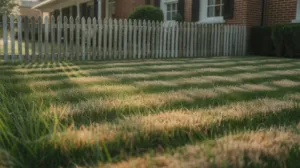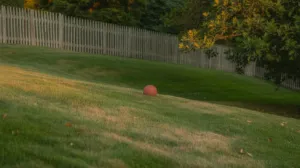
Why Does Your Lawn Turn Brown During The Summer?
Find Out the Most Typical Causes of Discolored Grass in the South
It can be annoying to see your once lush, green yard turn brown. Don’t freak out if your lawn is dying in the summer. Let’s examine the top five causes of your grass’s problems and what you (and Green Queen) can do to revitalize it in a sustainable manner.
1. Errors In Watering
Inappropriate watering practices cause many homeowners to unintentionally harm their lawns. When and how you water is crucial in hotter regions like the South.
The Right Way to Water in Summer:
- Best Time: Early morning (midnight-4 a.m.) is ideal since this reduces evaporation and prevents fungus.
- Deep & Infrequent: 1-1.5 inches per week in 1-2 sessions (not daily sprinkles).
- Measure Properly: Use a rain gauge or an empty tuna can to ensure even coverage.

Common Watering Mistakes:
- Evening watering can accidentally promote fungal diseases.
- Light, frequent sprinkles encourage shallow roots instead of strong, healthy ones.
- Overwatering will drown roots, especially in clay soil.
2. Is It Drought or Fungus?
When your lawn turns brown in the summer, especially in areas, it could indicate either drought stress or lawn disease, two very different issues. Here’s how to identify them.
Signs of Drought Stress:
- A uniform brown or gray color
- Soil that’s hard and cracked
- Grass blades curling inward
What’s the simplest way to fix it? Just change the schedule of when you water.
Signs of Lawn Fungus:
- Irregular brown/yellow patches
- Powdery or slimy residue on blades
- Musty odor in affected areas
Treatment:
- Apply an eco-friendly fungicide.
- Improve airflow by trimming overgrown shrubs.
- Avoid heavy nitrogen fertilizers in peak heat.
3. Cutting Grass Too Short
Scalping your lawn weakens grass, exposes soil, and invites weeds.
Here Are Some Summer Mowing Tips
The most important mowing tip we can offer is probably to never cut more than one-third of the blade height at once. But also? For Bermuda, keep your grass 1-2 inches tall, and for St. Augustine, 3-4 inches. Finally, keep in mind that dull mower blades can cause more harm than good, so always remember to sharpen them.
The Problem With Mowing Too Short
- Soil dries out faster
- Weeds (like crabgrass) take over
- Grass loses drought resistance
Bonus green tip: Leave clippings! They act as natural mulch, reducing water needs.
4. Dog Urine Damage
Seeing small, circular dead spots? Your pup’s probably the culprit.
Fix & Prevent Pet Damage By Doing This
- Rinse urine spots immediately with water.
- Train dogs to use a designated gravel or mulch area.
- Neutralize salts with environmentally friendly lawn repair treatments.
5. Southern Lawn Pests
Insects like grubs, chinch bugs, and sod webworms can really hurt your lawn in summer.
Signs of Pest Damage:
- Spongy turf that lifts easily (grubs)
- Yellow patches that spread (chinch bugs)
- Night-flying moths (sod webworms)
What’s the best way to get rid of bugs in the summer? Green Queen’s eco-friendly pest control professionals! Our focused treatments provide a family-friendly and pet-friendly method of getting rid of even the most harmful insects.

Stop Your Lawn Going Brown In The Summer
If your grass is dying in the heat and DIY fixes aren’t working, Green Queen can help. We proudly offer eco pest control and lawn care services to the following areas:
